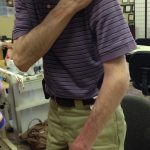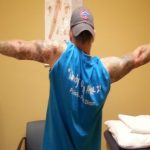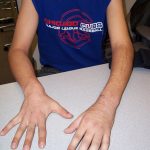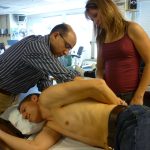



Tennessee 
The restoration of motion to the joints of the UE is one of the most common problems in rehabilitation. Overcoming stiff and painful joints is essential if the hand is to function properly, and this salient fact creates a formidable challenge for the hand therapist. In this talk, we will review the causes and treatment for stiff shoulder, elbow wrist and hand
- Shoulder: Adhesive Capsulitis, RTC repair, S/P labrum repair
- Elbow: Elbow fractures, ligament repairs
- Wrist: wrist fracture, CRPS, PRC
- Hand: Certain afflictions of the intrinsic muscles of the hand, Hand Fracture, crush hand
Secondary deformities are produced by the disturbance of the tendinous motion, loss of ligamentous control, which alters skeletal alignment. Secondary deformities could be divided into a) primary pathology or b) secondary changes.
Primary pathology may directly involve the joint, skeletal structures, tendons or ligaments
Whereas, the secondary pathology can be caused by Poor management of injuries, causing fixed deformities or A result of slow progression of missed progressive deformities that may result in management problem. Trauma, or disease process affecting the hand, requiring conservative or surgical management. Adhesion of the tendons, and/or contracture formation
The talk will include management of stiff arm with mechanically balanced positioning of the various joints following injury, surgery or disease process to elevate, reduce or minimize abnormal forces along with controlled mobilization that prevents the secondary deformities and maximizes the functioning of the arm.
KEY SPEAKERS:
- Saba Kamal – OTR, CHT
- Ashim Bakshi – MHS, OTR, CHT
COURSE DURATION:
- 2 days
- 14 CEU’s
This is a hands-on course that covers the essentials of joint mobilization and myofascial manipulation of the shoulder, elbow and the hand complex along with knowledge of splinting and modalities to treat the stiff arm. It is specifically designed for the practicing upper extremity specialist/ certified hand therapist to critically think and apply clinical reasoning to treat the stiff arm by using the above techniques. It covers intricate techniques to allow for decision making in treating patients with various complex UE injures.
The Underlying principles of wound healing, splinting and manual therapy provide the basic science behind the techniques that provides the foundation for the laboratory portion of the course. The lab portion of the course will consist of practical hands-on application of joint and soft tissue mobilization techniques to the upper extremity.
Relevant case studies will be presented that will incorporate the manual therapy skills learned during the course and clinical reasoning for application of specific modalities and splinting.
COURSE OBJECTIVE
- To gain knowledge of anatomical / pathological structures that can be affected by joint and soft tissue mobilizations. Also, utilizing the correct treatment tool in improving the ROM in patients with stiff arm
- Ability to perform concise clinical examination of the joints from an arthrokinematic perspective for the pathology at hand.
- Demonstrate clinical reasoning in applying modalities and orthosis along with performing joint and soft tissue mobilizations on the pathological upper extremity.
COURSE SCHEDULE
Day 1
07:45-08:00 Introduction
08:00-09:00 Joint/ Soft tissue Mobilization principles
09:00-10:00 Principles of splinting and wound healing
10:00-10:15 Break
10:10-11:00 Pathology of Stiff Shoulder: reasons for secondary deformity / biomechanics of pathologically stiff shoulder. Covers adhesive capsulitis, proximal humerus fracture, stiffness s/p RTC repair, Labrum A/P repair
11:00-12:00 Joint specific treatment techniques for shoulder mobilizations with progressions to improve ROM (movement with mobilization incorporated), soft tissue mobilizations along with use of modalities etc. Lab incorporating clinic reasoning behind techniques used
12:00-01:00 Lunch
01:00-02:30 Shoulder Lab with case studies
02:30-03:30 Elbow pathology and biomechanics of stiff elbow, covers Supracondylar fracture, terrible triads etc
03:30-03:45 Break
03:45-05:00 Treatment techniques for elbow mobilizations with progressions including movement with mobilization, soft tissue mobilization, modalities / splinting etc. Clinical reasoning discussed behind each technique utilized
05:00 Adjourn for the day/Questions
Day 2
08:00-09:00 Elbow Lab with case studies
09:00-09:30 PRUJ / DRUJ pathology and joint mobilization, biomechanics splinting modalities
09:30-10:30 Wrist pathology, biomechanics, includes wrist fracture management, CRPS
10:30-10:45 Break
10:45-12:00 Treatment techniques incorporating wrist joint mobilizations with progressions, soft tissue mobilization splinting / modalities discussion with case studies
12:00-01:00 Lunch
01:00-02:00 Hand pathology, intrinsic tightness, management of boutonniere, stiff hand
02:00-03:30 Techniques incorporating hand mobilizations with progressions, soft tissue management/ specific strengthening techniques, splinting ideas, modalities etc with case studies
03:30-04:00 Case Studies Questions/ Adjourn
DIAGNOSIS CONSIDERED FOR THIS COURSE
SHOULDER
- Adhesive capsulitis
- Proximal humeral fractures
- Post surgical joint issues as related to massive cuff repairs and proximal humeral fixation
- Considerations for post SLAP repairs
ELBOW
- Elbow dislocation
- Post fracture management- supracondylar, and olecranon fracture
- Management of the terrible triad
WRIST AND HAND
- Post fracture rehab
- Status post wrist ligamentous repair
- CRPS
- Intrinsic tightness of the hand